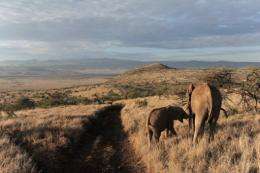Kenya sees rise in elephant population despite poaching

Despite increased poaching and a recent severe drought, Kenya has recorded a rise in elephant population in its flagship park, wildlife authorities announced Saturday.
Elephant population in the expansive Tsavo ecosystem in the south of the country rose to 12,572 from 11,696 three years ago according to the preliminary results of a census released Saturday.
The figures, which represent an increase of around two percent, is however less than the four percent rise that has been recorded in previous counts.
"This has happened in the backdrop of a very bad drought," said Julius Kipng'etich, the director of the Kenya Wildlife Service. "The new numbers might also reflect the increased demand for ivory and the subsequent rise in poaching."
The Tsavo National Park is Kenya's premier elephant sanctuary, hosting one third of its entire elephant population and covers 46,437 square kilometres of territory, an area bigger than Denmark and more than twice the size of Israel.
The expansive Tsavo is also the pulse on the status of Kenya's endangered elephants.
In 1976, Tsavo was home to some 35,000 elephants. In early 1970s, around 6,000 animals died during a harsh drought, and by 1988 only 5,400 remained in the park in the wake of a serious poaching onslaught.
However, the numbers have gradually grown since the early 1990s owing to tighter conservation and protection.
Conservationist Iain Douglas-Hamilton, the founder of Save the Elephants organisation said the latest figures were "hugely significant not only for Kenya but for Africa."
The wildlife authorities also raised alarm over the surge in illegal ivory trade after southern African countries of South Africa, Botswana, Namibia and Zimbabwe were allowed a one-off stockpile sale in 2008 to Japan and China.
Kenya has in recent months arrested several people trafficking ivory through its main airport in Nairobi to Asian countries where the tusks are used in traditional medicines and ornaments.
"Whilst this census is integral to the conservation and management of elephants, the real challenge remains in protecting them from threats such as poaching and challenges brought forth by land use changes," said James Isiche of the International Fund for Animal Welfare.
(c) 2011 AFP














